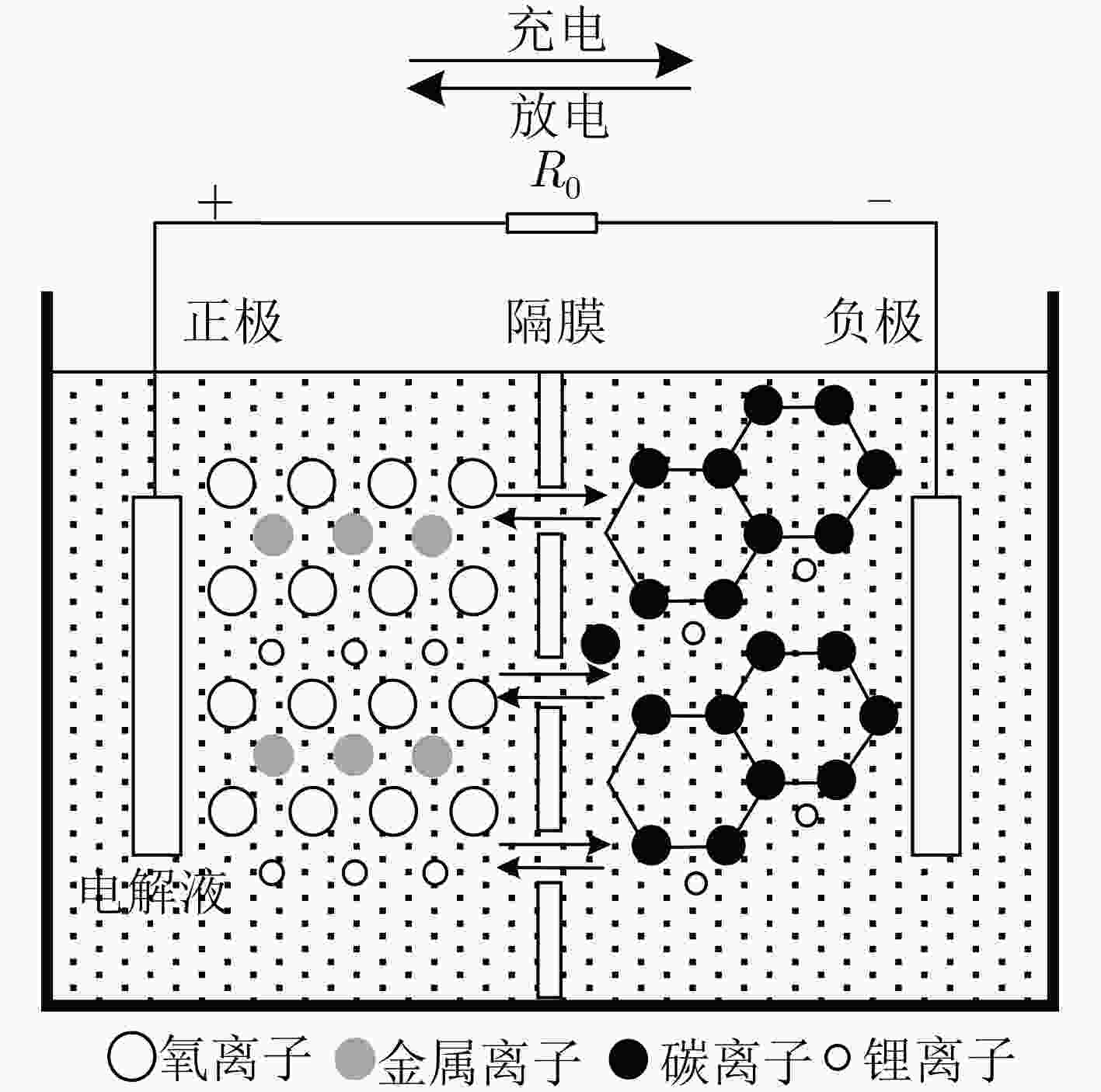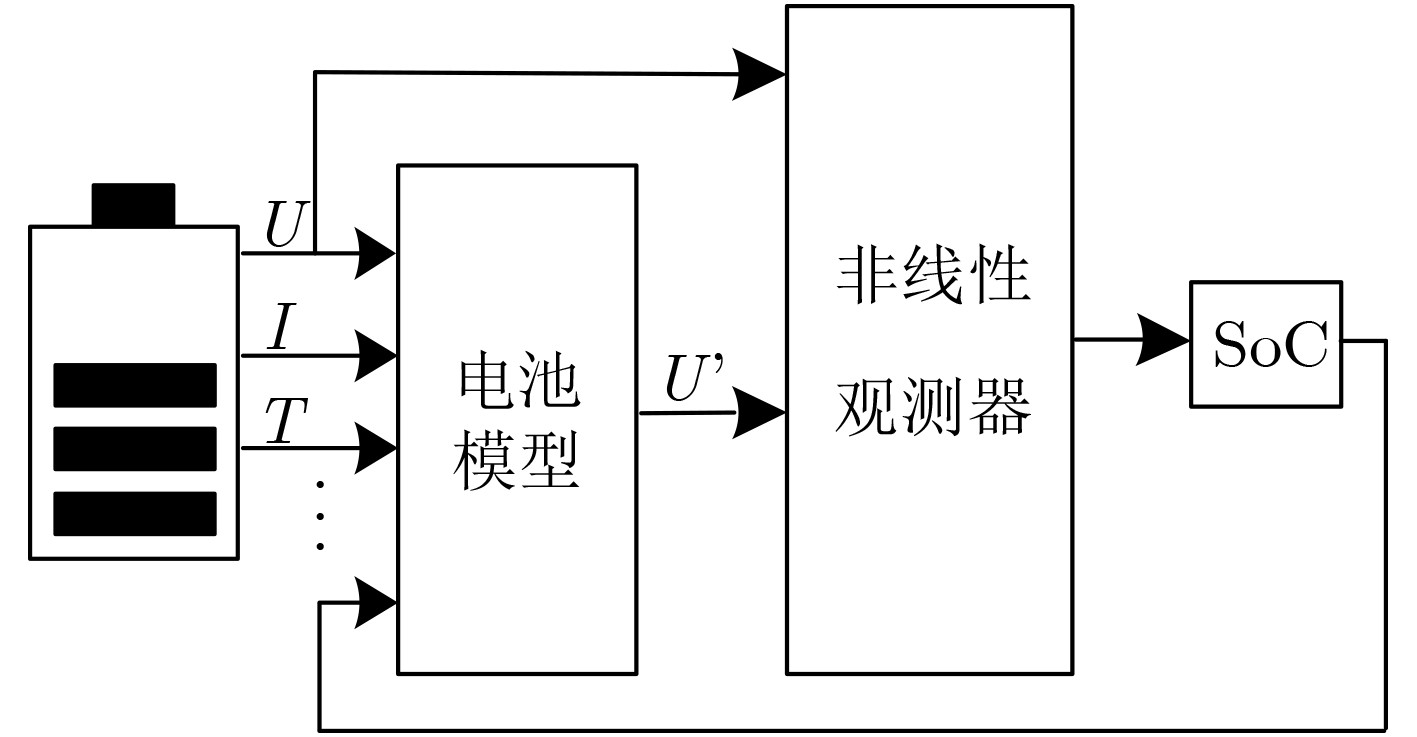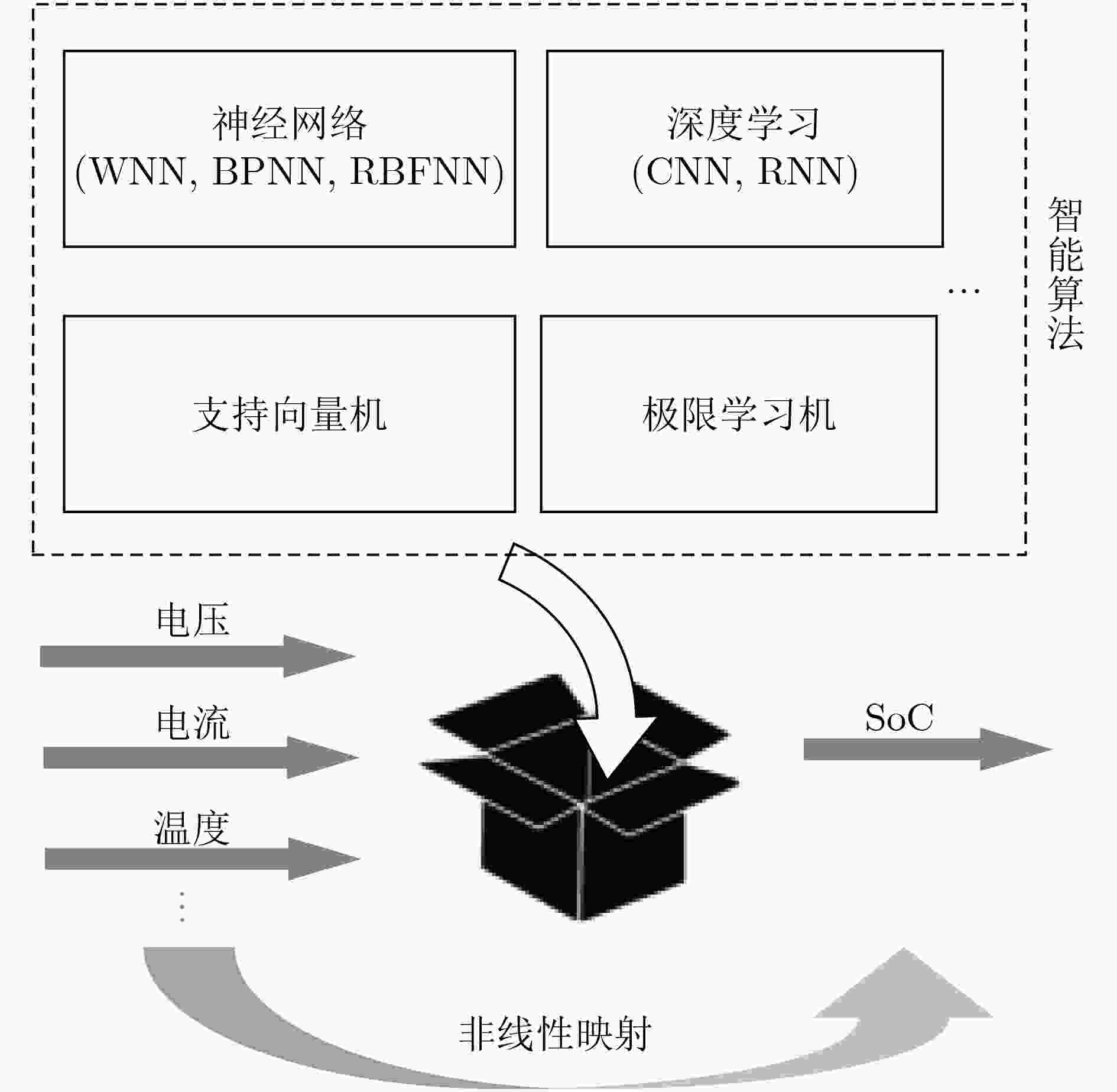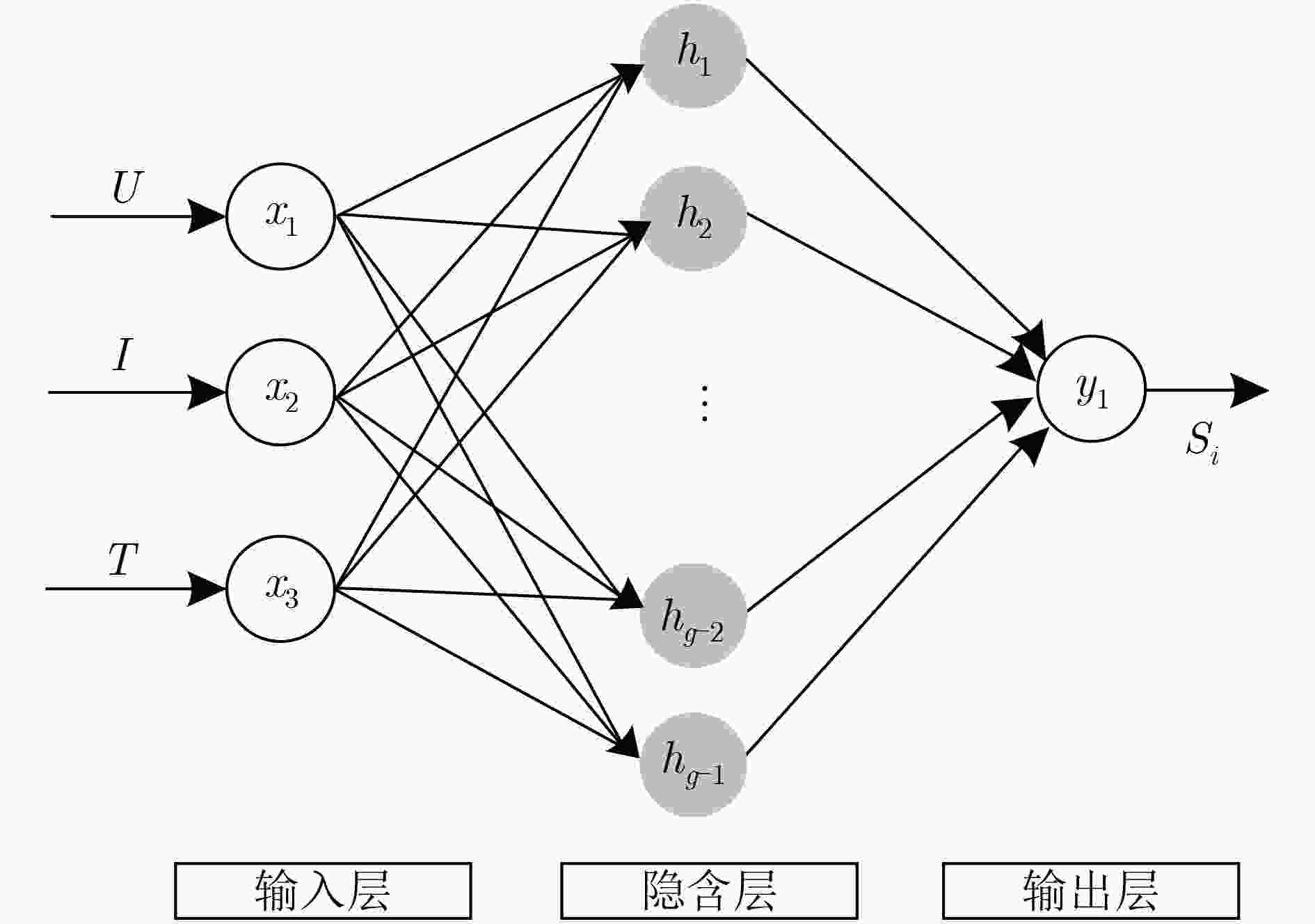Review of SoC Estimation Methods for Electric Vehicle Li-ion Batteries
-
摘要: 锂离子电池具有循环寿命长、能量密度高、自放电率低、环境污染小等优点,在电动汽车产业中得到广泛应用。电动汽车中的电池管理系统(BMS)可以维护和监测电池状态,确保电池的安全性和可靠性。电池荷电状态(SoC)表示电池中剩余的电量,是BMS的重要参数之一,实时精确的SoC估算可以延长电池寿命,保障行驶安全。然而锂离子电池是一个高度复杂的非线性时变系统,电池寿命、环境温度、电池自放电等许多未知因素均会对估算精度造成影响,使估算难度大大增加。为了满足不同条件下对锂离子电池SoC精确、快速、实时估算的要求,需要对SoC估计算法进行进一步研究与改进。近年来已有相关文献对锂离子电池SoC的估算方法进行了综述,然而已有相关综述对估算方法的总结不够全面且缺少流程表达。该文首先介绍了锂离子电池的工作原理,阐述了影响电池SoC估算的因素;其次,通过总结最新的研究成果对电池SoC估算方法进行了归纳分析,根据各类算法的不同特性将其分为查表法、安时积分法、基于模型的方法、数据驱动的方法以及混合方法五大类,说明了各类估算方法的主要特征并对模型或算法的优缺点进行综合的比较和讨论;最后,对电动汽车中锂离子电池SoC估算方法的未来发展方向做出展望。Abstract: Lithium-ion battery has been widely used in electric vehicle industry because of its long cycle life, high energy density, low self-discharge rate and low environmental pollution. The Battery Management System (BMS) in electric vehicles can maintain and monitor the battery status to ensure the security and reliability of the battery. The battery’s State of Charge (SoC) represents the remaining power in the battery and is one of the important parameters of the BMS. Real-time and accurate SoC estimation can extend battery life and ensure driving safety. However, Lithium-ion battery is indeed a highly complex nonlinear time-varying system, many unknown factors, such as battery life, ambient temperature, battery self-discharge and so on, will affect the estimation accuracy, which greatly increases the difficulty of estimation. To meet the requirements of accurate, rapid and real-time SoC estimation for Lithium-ion batteries under different conditions, further research and improvement of SoC estimation algorithm are needed. In recent years, some review literature on the Lithium-ion battery SoC estimation has been published. However, the existing literature has not summarized the estimation methods comprehensively and lack of process description. In this paper, the working principle of Lithium-ion battery is firstly introduced, as well as the factors affecting the SoC estimation of battery. Secondly, summary and analysis of the battery SoC estimation methods are conducted by the latest research achievement. According to the different characteristics of various algorithms, the battery SoC estimation can be divided into five categories: look-up table method, ampere hour integration method, model-based method, data-driven method and hybrid method. The main characteristics of various estimation methods are explained and the advantages and disadvantages of models or algorithms are comprehensively compared and discussed. Finally, the future development direction of SoC estimation methods for Lithium-ion batteries in electric vehicles is prospected.
-
表 1 4种常用等效电路模型
等效电路模型 器件组成 模型特性方程 等效电路 参数辨识复杂程度 特点 Rint模型 Uv, R0 Ut=Uv–IR0 
简单 模型简单;精度差;无法模拟
电池动态特性Thevenin模型 Uv,R0, R1,C1 U1=IR1·[1–e–t/τ1]
Ut=Uv–IR0–U1
复杂 考虑了电池极化的影响 2阶电阻电容
并联等效模型Uv,R0,R1, C1,R2,C2 U1=IR1·[1–e–t/τ1]
U2=IR2·[1–e–t/τ2]
Ut=Uv–IR0–U1–U2
非常复杂 考虑了电池极化的影响;
模型精度高PNGV模型 Uv, R0, R1, C1, C3 U1=IR1·[1–e–t/τ1]
U3=I/C3
Ut=Uv–IR0–U1–U3
非常复杂 考虑负载电流对OCV的影响 表 2 各类SoC估计方法的主要优点和缺点
估算方法 优点 缺点 查表法 准确、可靠、原理简单 耗时长、能源浪费、不能实时估计 安时积分法 估算速度快、易实现 开环估计方法,存在累计误差 基于模型的估算方法 闭环估计,不需要精确的SoC初始值、估算误差小 建模困难、参数辨识难度大、计算量大 基于数据方法 不需要对电池建模、可以自学习网络参数、计算量小 对数据要求高、离线训练耗时长 混合方法 估算精度高、有很好的泛化性和鲁棒性 计算复杂、能耗大、估算速度慢 -
[1] CHEN Lin, WANG Zhengzheng, LV Zhiqiang, et al. A novel state-of-charge estimation method of lithium-ion batteries combining the grey model and genetic algorithms[J]. IEEE Transactions on Power Electronics, 2018, 33(10): 8797–8807. doi: 10.1109/TPEL.2017.2782721 [2] TIAN Yong, LAI Rucong, LI Xiaoyu, et al. A combined method for state-of-charge estimation for lithium-ion batteries using a long short-term memory network and an adaptive cubature Kalman filter[J]. Applied Energy, 2020, 265: 114789. doi: 10.1016/j.apenergy.2020.114789 [3] JIN Long, LI Shuai, and HU Bin. RNN models for dynamic matrix inversion: A control-theoretical perspective[J]. IEEE Transactions on Industrial Informatics, 2018, 14(1): 189–199. doi: 10.1109/TII.2017.2717079 [4] XIONG Rui, CAO Jiayi, YU Quanqing, et al. Critical review on the battery state of charge estimation methods for electric vehicles[J]. IEEE Access, 2018, 6: 1832–1843. doi: 10.1109/ACCESS.2017.2780258 [5] ALI M U, ZAFAR A N, NENGROO S H, et al. Towards a smarter battery management system for electric vehicle applications: A critical review of lithium-ion battery state of charge estimation[J]. Energies, 2019, 12(3): 446. doi: 10.3390/en12030446 [6] SHEN Ping, OUYANG Minggao, HAN Xuebing, et al. Error analysis of the model-based state-of-charge observer for lithium-ion batteries[J]. IEEE Transactions on Vehicular Technology, 2018, 67(9): 8055–8064. doi: 10.1109/TVT.2018.2842820 [7] MOUSSALLI Z, SEDRA M B, and LAACHIR A A. State of charge estimation algorithms in lithium-ion battery-powered electric vehicles[C]. 2018 International Conference on Electronics, Control, Optimization and Computer Science, Kenitra, Morocco, 2018: 1–6. [8] JULIEN C, MAUGER A, VIJH A, et al. Lithium Batteries: Science and Technology[M]. Switzerland: Springer, 2016: 29–34. [9] YONG Jiaying, RAMACHANDARAMURTHY V K, TAN Kangmiao, et al. A review on the state-of-the-art technologies of electric vehicle, its impacts and prospects[J]. Renewable and Sustainable Energy Reviews, 2015, 49: 365–385. doi: 10.1016/j.rser.2015.04.130 [10] PATTIPATI B, SANKAVARAM C, and PATTIPATI K. System identification and estimation framework for pivotal automotive battery management system characteristics[J]. IEEE Transactions on Systems, Man, and Cybernetics, Part C (Applications and Reviews) , 2011, 41(6): 869–884. doi: 10.1109/TSMCC.2010.2089979 [11] LI Jianhua and LIU Mingsheng. State-of-charge estimation of batteries based on open-circuit voltage and time series neural network[C]. The 2019 6th International Conference on Systems and Informatics, Shanghai, China, 2019. doi: 10.1109/ICSAI48974.2019.9010535. [12] WU S L, CHEN H C, TSAI M Y, et al. AC impedance based online state-of-charge estimation for li-ion battery[C]. 2017 International Conference on Information, Communication and Engineering, Xiamen, China, 2017: 53–56. doi: 10.1109/ICICE.2017.8479183. [13] SHEN Ping, OUYANG Minggao, LU Languang, et al. The co-estimation of state of charge, state of health, and state of function for lithium-ion batteries in electric vehicles[J]. IEEE Transactions on Vehicular Technology, 2018, 67(1): 92–103. doi: 10.1109/TVT.2017.2751613 [14] BARAI A, WIDANAGE W D, MARCO J, et al. A study of the open circuit voltage characterization technique and hysteresis assessment of lithium-ion cells[J]. Journal of Power Sources, 2015, 295: 99–107. doi: 10.1016/j.jpowsour.2015.06.140 [15] YANG Fangfang, SONG Xiangbao, XU Fan, et al. State-of-charge estimation of lithium-ion batteries via long short-term memory network[J]. IEEE Access, 2019, 7: 53792–53799. doi: 10.1109/ACCESS.2019.2912803 [16] TRUCHOT C, DUBARRY M, and LIAW B Y. State-of-charge estimation and uncertainty for lithium-ion battery strings[J]. Applied Energy, 2014, 119: 218–227. doi: 10.1016/j.apenergy.2013.12.046 [17] LASHWAY C R and MOHAMMED O A. Adaptive battery management and parameter estimation through physics-based modeling and experimental verification[J]. IEEE Transactions on Transportation Electrification, 2016, 2(4): 454–464. doi: 10.1109/TTE.2016.2558843 [18] NG K S, MOO C S, CHEN Y P, et al. Enhanced coulomb counting method for estimating state-of-charge and state-of-health of lithium-ion batteries[J]. Applied Energy, 2009, 86(9): 1506–1511. doi: 10.1016/j.apenergy.2008.11.021 [19] ZHENG Yuejiu, OUYANG Minggao, HAN Xuebing, et al. Investigating the error sources of the online state of charge estimation methods for lithium-ion batteries in electric vehicles[J]. Journal of Power Sources, 2018, 377: 161–188. doi: 10.1016/j.jpowsour.2017.11.094 [20] FULLER T F, DOYLE M, and NEWMAN J. Simulation and optimization of the dual lithium ion insertion cell[J]. Journal of the Electrochemical Society, 1994, 141(1): 1–10. doi: 10.1149/1.2054684 [21] LOTFI N, LANDERS R G, LI Jie, et al. Reduced-order electrochemical model-based SOC observer with output model uncertainty estimation[J]. IEEE Transactions on Control Systems Technology, 2017, 25(4): 1217–1230. doi: 10.1109/TCST.2016.2598764 [22] LIU Guangming, LU Languang, FU Hong, et al. A comparative study of equivalent circuit models and enhanced equivalent circuit models of lithium-ion batteries with different model structures[C]. 2014 IEEE Conference and Expo Transportation Electrification Asia-Pacific, Beijing, China, 2014: 1–6. doi: 10.1109/ITEC-AP.2014.6940946. [23] LUO Yifeng, GONG C S A, CHANG Longxi, et al. AC impedance technique for dynamic and static state of charge analysis for Li-ion battery[C]. 2013 IEEE International Symposium on Consumer Electronics, Hsinchu, China, 2013: 9–10. doi: 10.1109/ISCE.2013.6570268. [24] EDDAHECH A, BRIAT O, BERTRAND N, et al. Behavior and state-of-health monitoring of Li-ion batteries using impedance spectroscopy and recurrent neural networks[J]. International Journal of Electrical Power & Energy Systems, 2012, 42(1): 487–494. doi: 10.1016/j.ijepes.2012.04.050 [25] Wang Qiankun, HE Yijun, SHEN Jiani, et al. State of charge-dependent polynomial equivalent circuit modeling for electrochemical impedance spectroscopy of lithium-ion batteries[J]. IEEE Transactions on Power Electronics, 2018, 33(10): 8449–8460. doi: 10.1109/TPEL.2017.2780184 [26] HE Hongwen, XIONG Rui, GUO Hongqiang, et al. Comparison study on the battery models used for the energy management of batteries in electric vehicles[J]. Energy Conversion and Management, 2012, 64: 113–121. doi: 10.1016/j.enconman.2012.04.014 [27] LAI Xin, ZHENG Yuejiu, and SUN Tao. A comparative study of different equivalent circuit models for estimating state-of-charge of lithium-ion batteries[J]. Electrochimica Acta, 2018, 259: 566–577. doi: 10.1016/j.electacta.2017.10.153 [28] NEMES R, CIORNEI S, RUBA M, et al. Modeling and simulation of first-order Li-Ion battery cell with experimental validation[C]. The 2019 8th International Conference on Modern Power Systems, Cluj Napoca, Romania, 2019. doi: 10.1109/MPS.2019.8759769. [29] HE Hongwen, XIONG Rui, ZHANG Xiaowei, et al. State-of-charge estimation of the lithium-ion battery using an adaptive extended Kalman filter based on an improved thevenin model[J]. IEEE Transactions on Vehicular Technology, 2011, 60(4): 1461–1469. doi: 10.1109/TVT.2011.2132812 [30] ZHANG Xi, LU Jinling, YUAN Shifei, et al. A novel method for identification of lithium-ion battery equivalent circuit model parameters considering electrochemical properties[J]. Journal of Power Sources, 2017, 345: 21–29. doi: 10.1016/j.jpowsour.2017.01.126 [31] HE Hongwen, XIONG Rui, and FAN Jinxin. Evaluation of lithium-ion battery equivalent circuit models for state of charge estimation by an experimental approach[J]. Energies, 2011, 4(4): 582–598. doi: 10.3390/en4040582 [32] LIU Xiangyong, LI Wanli, and ZHOU Aiguo. PNGV equivalent circuit model and SOC estimation algorithm for lithium battery pack adopted in AGV vehicle[J]. IEEE Access, 2018, 6: 23639–23647. doi: 10.1109/ACCESS.2018.2812421 [33] ZOU Changfu, HU Xiaosong, DEY S, et al. Nonlinear fractional-order estimator with guaranteed robustness and stability for lithium-ion batteries[J]. IEEE Transactions on Industrial Electronics, 2018, 65(7): 5951–5961. doi: 10.1109/TIE.2017.2782691 [34] YU Quanqing, XIONG Rui, and LIN Cheng. Online estimation of state-of-charge based on the H infinity and unscented Kalman filters for lithium ion batteries[J]. Energy Procedia, 2017, 105: 2791–2796. doi: 10.1016/j.egypro.2017.03.600 [35] NEJAD S, GLADWIN D T, and STONE D A. A systematic review of lumped-parameter equivalent circuit models for real-time estimation of lithium-ion battery states[J]. Journal of Power Sources, 2016, 316: 183–196. doi: 10.1016/j.jpowsour.2016.03.042 [36] HE Hongwen, XIONG Rui, and PENG Jiankun. Real-time estimation of battery state-of-charge with unscented Kalman filter and RTOS μCOS-II platform[J]. Applied Energy, 2016, 162: 1410–1418. doi: 10.1016/j.apenergy.2015.01.120 [37] PAN Haihong, LV Zhiqiang, LIN Weilong, et al. State of charge estimation of lithium-ion batteries using a grey extended Kalman filter and a novel open-circuit voltage model[J]. Energy, 2017, 138: 764–775. doi: 10.1016/j.energy.2017.07.099 [38] DONG Guangzhong, WEI Jingwen, and CHEN Zonghai. Kalman filter for onboard state of charge estimation and peak power capability analysis of lithium-ion batteries[J]. Journal of Power Sources, 2016, 328: 615–626. doi: 10.1016/j.jpowsour.2016.08.065 [39] WANG Yujie, ZHANG Chenbin, and CHEN Zonghai. A method for state-of-charge estimation of LiFePO4 batteries at dynamic currents and temperatures using particle filter[J]. Journal of Power Sources, 2015, 279: 306–311. doi: 10.1016/j.jpowsour.2015.01.005 [40] BARTLETT A, MARCICKI J, ONORI S, et al. Electrochemical model-based state of charge and capacity estimation for a composite electrode lithium-ion battery[J]. IEEE Transactions on Control Systems Technology, 2016, 24(2): 384–399. doi: 10.1109/TCST.2015.2446947 [41] AUNG H and LOW K S. Temperature dependent state-of-charge estimation of lithium ion battery using dual spherical unscented Kalman filter[J]. IET Power Electronics, 2015, 8(10): 2026–2033. doi: 10.1049/iet-pel.2014.0863 [42] AUNG H, LOW K S, and GOH S T. State-of-charge estimation of lithium-ion battery using square root spherical unscented Kalman filter (Sqrt-UKFST) in nanosatellite[J]. IEEE Transactions on Power Electronics, 2015, 30(9): 4774–4783. doi: 10.1109/TPEL.2014.2361755 [43] ZHU Qiao, LI Liang, HU Xiaosong, et al. H∞-based nonlinear observer design for state of charge estimation of lithium-ion battery with polynomial parameters[J]. IEEE Transactions on Vehicular Technology, 2017, 66(12): 10853–10865. doi: 10.1109/TVT.2017.2723522 [44] LIU Congzhi, ZHU Qiao, LI Liang, et al. A state of charge estimation method based on H∞ observer for switched systems of lithium-ion nickel–manganese–cobalt batteries[J]. IEEE Transactions on Industrial Electronics, 2017, 64(10): 8128–8137. doi: 10.1109/TIE.2017.2701766 [45] TANG Xiaopeng, WANG Yujie, and CHEN Zonghai. A method for state-of-charge estimation of LiFePO4 batteries based on a dual-circuit state observer[J]. Journal of Power Sources, 2015, 296: 23–29. doi: 10.1016/j.jpowsour.2015.07.028 [46] XU Jun, MI C C, CAO Binggang, et al. The state of charge estimation of lithium-ion batteries based on a proportional-integral observer[J]. IEEE Transactions on Vehicular Technology, 2014, 63(4): 1614–1621. doi: 10.1109/TVT.2013.2287375 [47] XIONG Binyu, ZHAO Jiyun, SU Yixin, et al. State of charge estimation of vanadium redox flow battery based on sliding mode observer and dynamic model including capacity fading factor[J]. IEEE Transactions on Sustainable Energy, 2017, 8(4): 1658–1667. doi: 10.1109/TSTE.2017.2699288 [48] CHEN Xiaopeng, SHEN Weixiang, DAI Mingxiang, et al. Robust adaptive sliding-mode observer using RBF neural network for lithium-ion battery state of charge estimation in electric vehicles[J]. IEEE Transactions on Vehicular Technology, 2016, 65(4): 1936–1947. doi: 10.1109/TVT.2015.2427659 [49] WANG Baojin, LIU Zhiyuan, LI S E, et al. State-of-charge estimation for lithium-ion batteries based on a nonlinear fractional model[J]. IEEE Transactions on Control Systems Technology, 2017, 25(1): 3–11. doi: 10.1109/TCST.2016.2557221 [50] HU Xiaosong, SUN Fengchun, and ZOU Yuan. Estimation of state of charge of a lithium-ion battery pack for electric vehicles using an adaptive luenberger observer[J]. Energies, 2010, 3(9): 1586–1603. doi: 10.3390/en3091586 [51] XING Yinjiao, HE Wei, PECHT M, et al. State of charge estimation of lithium-ion batteries using the open-circuit voltage at various ambient temperatures[J]. Applied Energy, 2014, 113: 106–115. doi: 10.1016/j.apenergy.2013.07.008 [52] YANG Fangfang, XING Yinjiao, WANG Dong, et al. A comparative study of three model-based algorithms for estimating state-of-charge of lithium-ion batteries under a new combined dynamic loading profile[J]. Applied Energy, 2016, 164: 387–399. doi: 10.1016/j.apenergy.2015.11.072 [53] PARK J, KIM G, NA W, et al. Nonlinear observer and simplified equivalent circuit model-based EKF-SoC estimator of a rechargeable LiFePo4 cell[C]. The 2019 10th International Conference on Power Electronics and ECCE Asia, Busan, Korea (South), 2019. [54] YAN Wuzhao, ZHANG Bin, ZHAO Guangquan, et al. A battery management system with a lebesgue-sampling-based extended kalman filter[J]. IEEE Transactions on Industrial Electronics, 2019, 66(4): 3227–3236. doi: 10.1109/tie.2018.2842782 [55] HE Hongwen, QIN Hongzhou, SUN Xiaokun, et al. Comparison study on the battery SOC estimation with EKF and UKF algorithms[J]. Energies, 2013, 6(10): 5088–5100. doi: 10.3390/en6105088 [56] WANG Weida, WANG Xiantao, XIANG Changle, et al. Unscented kalman filter-based battery SOC estimation and peak power prediction method for power distribution of hybrid electric vehicles[J]. IEEE Access, 2018, 6: 35957–35965. doi: 10.1109/ACCESS.2018.2850743 [57] EI DIN M S, HUSSEIN A A, and ABDEL-HAFEZ M F. Improved battery SOC estimation accuracy using a modified UKF with an adaptive cell model under real EV operating conditions[J]. IEEE Transactions on Transportation Electrification, 2018, 4(2): 408–417. doi: 10.1109/TTE.2018.2802043 [58] PENG Simin, CHEN Chong, SHI Hongbing, et al. State of charge estimation of battery energy storage systems based on adaptive unscented Kalman filter with a noise statistics estimator[J]. IEEE Access, 2017, 5: 13202–13212. doi: 10.1109/ACCESS.2017.2725301 [59] HE Cheng, LIU Changchun, WU Yang, et al. Estimation for SOC of electric vehical lithium battery based on artificial immune particle filter[C]. The 2018 3rd International Conference on Smart City and Systems Engineering, Xiamen, China, 2018: 675–678. doi: 10.1109/ICSCSE.2018.00145. [60] ZHANG Kai, MA Jian, ZHAO Xuan, et al. State of charge estimation for lithium battery based on adaptively weighting cubature particle filter[J]. IEEE Access, 2019, 7: 166657–166666. doi: 10.1109/access.2019.2953478 [61] HE Yao, LIU Xingtao, ZHANG Chenbin, et al. A new model for State-of-Charge (SOC) estimation for high-power Li-ion batteries[J]. Applied Energy, 2013, 101: 808–814. doi: 10.1016/j.apenergy.2012.08.031 [62] SHEN Yanqing. Hybrid unscented particle filter based state-of-charge determination for lead-acid batteries[J]. Energy, 2014, 74: 795–803. doi: 10.1016/j.energy.2014.07.051 [63] ELSAYED A and GRIMBLE M J. A new approach to H∞ design of optimal digital linear filters[J]. IMA Journal of Mathematical Control and Information, 1989, 6(2): 233–251. doi: 10.1093/imamci/6.2.233 [64] ZHANG Fei, LIU Guangjun, FANG Lijin, et al. Estimation of battery state of charge with H∞ observer: Applied to a robot for inspecting power transmission lines[J]. IEEE Transactions on Industrial Electronics, 2012, 59(2): 1086–1095. doi: 10.1109/TIE.2011.2159691 [65] CHEN Ning, ZHANG Peng, DAI Jiayang, et al. Estimating the state-of-charge of lithium-ion battery using an h-infinity observer based on electrochemical impedance model[J]. IEEE Access, 2020, 8: 26872–26884. doi: 10.1109/ACCESS.2020.2971002 [66] CACCIATO M, NOBILE G, SCARCELLA G, et al. Real-time model-based estimation of SOC and SOH for energy storage systems[J]. IEEE Transactions on Power Electronics, 2017, 32(1): 794–803. doi: 10.1109/TPEL.2016.2535321 [67] WEI Zhongbao, MENG Shujuan, XIONG Binyu, et al. Enhanced online model identification and state of charge estimation for lithium-ion battery with a FBCRLS based observer[J]. Applied Energy, 2016, 181: 332–341. doi: 10.1016/j.apenergy.2016.08.103 [68] ZHONG Qishui, ZHONG Fuli, CHENG Jun, et al. State of charge estimation of lithium-ion batteries using fractional order sliding mode observer[J]. ISA Transactions, 2017, 66: 448–459. doi: 10.1016/j.isatra.2016.09.017 [69] DAI Kangwei, WANG Ju, and HE Hongwen. An improved SOC estimator using time-varying discrete sliding mode observer[J]. IEEE Access, 2019, 7: 115463–115472. doi: 10.1109/ACCESS.2019.2932507 [70] HOSSAIN LIPU M S, HANNAN M A, HUSSAIN A, et al. Extreme learning machine model for state-of-charge estimation of lithium-ion battery using gravitational search algorithm[J]. IEEE Transactions on Industry Applications, 2019, 55(4): 4225–4234. doi: 10.1109/TIA.2019.2902532 [71] HU Xiaosong, LI S E, and YANG Yalian. Advanced machine learning approach for lithium-ion battery state estimation in electric vehicles[J]. IEEE Transactions on Transportation Electrification, 2016, 2(2): 140–149. doi: 10.1109/TTE.2015.2512237 [72] 董哲康, 杜晨杰, 林辉品, 等. 基于多通道忆阻脉冲耦合神经网络的多帧图像超分辨率重建算法[J]. 电子与信息学报, 2020, 42(4): 835–843. doi: 10.11999/JEIT190868DONG Zhekang, DU Chenjie, LIN Huipin, et al. Multi-channel memristive pulse coupled neural network based multi-frame images super-resolution reconstruction algorithm[J]. Journal of Electronics &Information Technology, 2020, 42(4): 835–843. doi: 10.11999/JEIT190868 [73] ÁLVAREZ ANTÓN J C, GARCÍA NIETO P J, BLANCO VIEJO C, et al. Support vector machines used to estimate the battery state of charge[J]. IEEE Transactions on Power Electronics, 2013, 28(12): 5919–5926. doi: 10.1109/TPEL.2013.2243918 [74] 刘彬, 杨有恒, 赵志彪, 等. 一种基于正则优化的批次继承极限学习机算法[J]. 电子与信息学报, 2020, 42(7): 1734–1742. doi: 10.11999/JEIT190502LIU Bin, YANG Youheng, ZHAO Zhibiao, et al. A batch inheritance extreme learning machine algorithm based on regular optimization[J]. Journal of Electronics &Information Technology, 2020, 42(7): 1734–1742. doi: 10.11999/JEIT190502 [75] EDDAHECH A, BRIAT O, and VINASSA J M. Adaptive voltage estimation for EV Li-ion cell based on artificial neural networks state-of-charge meter[C]. 2012 IEEE International Symposium on Industrial Electronics, Hangzhou, China, 2012: 1318–1324. doi: 10.1109/ISIE.2012.6237281. [76] ZHOU Fengwu, WANG Lujun, LIN Huiping, et al. High accuracy state-of-charge online estimation of EV/HEV lithium batteries based on adaptive wavelet neural network[C]. 2013 ECCE Asia Downunder, Melbourne, Australia, 2013: 513–517. doi: 10.1109/ECCE-Asia.2013.6579145. [77] GAO L, SONG Y, and DOUGAL R A. Wavelet neural network based battery state-of-charge estimation for portable electronics applications[C]. The 20th Annual IEEE Applied Power Electronics Conference and Exposition, Austin, USA, 2005: 998–1002. doi: 10.1109/APEC.2005.1453111. [78] TONG Shijie, LACAP J H, and PARK J W. Battery state of charge estimation using a load-classifying neural network[J]. Journal of Energy Storage, 2016, 7: 236–243. doi: 10.1016/j.est.2016.07.002 [79] KANG Liuwang, ZHAO Xuan, and MA Jian. A new neural network model for the state-of-charge estimation in the battery degradation process[J]. Applied Energy, 2014, 121: 20–27. doi: 10.1016/j.apenergy.2014.01.066 [80] CUI Deyu, XIA Bizhong, ZHANG Ruifeng, et al. A novel intelligent method for the state of charge estimation of lithium-ion batteries using a discrete wavelet transform-based wavelet neural network[J]. Energies, 2018, 11(4): 995. doi: 10.3390/en11040995 [81] LIPU M S H, HANNAN M A, HUSSAIN A, et al. Optimal BP neural network algorithm for state of charge estimation of lithium-ion battery using PSO with PCA feature selection[J]. Journal of Renewable and Sustainable Energy, 2017, 9(6): 064102. doi: 10.1063/1.5008491 [82] LIU Yanwei, ZHAO Kegang, HUANG Xiangdong, et al. A new method based on RBFNN in SOC estimation of HEV battery[C]. The 29th Chinese Control Conference, Beijing, China, 2010: 4923–4927. [83] ABBAS G, NAWAZ M, and KAMRAN F. Performance comparison of NARX & RNN-LSTM neural networks for LiFePO4 battery state of charge estimation[C]. The 2019 16th International Bhurban Conference on Applied Sciences and Technology, Islamabad, Pakistan, 2019: 463–468. [84] YANG Fangfang, LI Weihua, LI Chuan, et al. State-of-charge estimation of lithium-ion batteries based on gated recurrent neural network[J]. Energy, 2019, 175: 66–75. doi: 10.1016/j.energy.2019.03.059 [85] HASTIE T, TIBSHIRANI R, and FRIEDMAN J. The Elements of Statistical Learning[M]. New York: Springer, 2009: 745. [86] SCHÖLKOPF B and SMOLA A J. Learning with Kernels: Support Vector Machines, Regularization, Optimization, and Beyond[M]. Cambridge: MIT Press, 2001: 187–188. [87] LI Ran, XU Shihui, LI Sibo, et al. State of charge prediction algorithm of lithium-ion battery based on PSO-SVR cross validation[J]. IEEE Access, 2020, 8: 10234–10242. doi: 10.1109/ACCESS.2020.2964852 [88] ZHANG Li, LI Kang, DU Dajun, et al. A sparse least squares support vector machine used for SOC estimation of Li-ion Batteries[J]. IFAC-PapersOnLine, 2019, 52(11): 256–261. doi: 10.1016/j.ifacol.2019.09.150 [89] HUANG Guangbin, ZHU Qinyu, and SIEW C K. Extreme learning machine: Theory and applications[J]. Neurocomputing, 2006, 70(1/3): 489–501. doi: 10.1016/j.neucom.2005.12.126 [90] DU Jiani, LIU Zhitao, and WANG Youyi. State of charge estimation for Li-ion battery based on model from extreme learning machine[J]. Control Engineering Practice, 2014, 26: 11–19. doi: 10.1016/j.conengprac.2013.12.014 [91] LIU Shiqi, WANG Junhua, LIU Qisheng, et al. Deep-discharging li-ion battery state of charge estimation using a partial adaptive forgetting factors least square method[J]. IEEE Access, 2019, 7: 47339–47352. doi: 10.1109/ACCESS.2019.2909274 [92] MENG Jinhao, STROE D I, RICCO M, et al. A simplified model-based state-of-charge estimation approach for lithium-ion battery with dynamic linear model[J]. IEEE Transactions on Industrial Electronics, 2019, 66(10): 7717–7727. doi: 10.1109/TIE.2018.2880668 [93] SHEN Yanqing. A combined state space model with adaptive neural compensator based state of charge determination method for lithium-ion batteries[J]. Electrochimica Acta, 2020, 336: 135664. doi: 10.1016/j.electacta.2020.135664 [94] OUYANG Quan, CHEN Jian, and ZHENG Jian. State-of-charge observer design for batteries with online model parameter identification: A robust approach[J]. IEEE Transactions on Power Electronics, 2020, 35(6): 5820–5831. doi: 10.1109/TPEL.2019.2948253 [95] AWADALLAH M A and VENKATESH B. Accuracy improvement of SOC estimation in lithium-ion batteries[J]. Journal of Energy Storage, 2016, 6: 95–104. doi: 10.1016/j.est.2016.03.003 [96] ZAHID T, XU Kun, LI Weimin, et al. State of charge estimation for electric vehicle power battery using advanced machine learning algorithm under diversified drive cycles[J]. Energy, 2018, 162: 871–882. doi: 10.1016/j.energy.2018.08.071 [97] SHEN W X, CHAN C C, LO E W, et al. Adaptive neuro-fuzzy modeling of battery residual capacity for electric vehicles[J]. IEEE Transactions on Industrial Electronics, 2002, 49(3): 677–684. doi: 10.1109/TIE.2002.1005395 -






 下载:
下载:






 下载:
下载:
